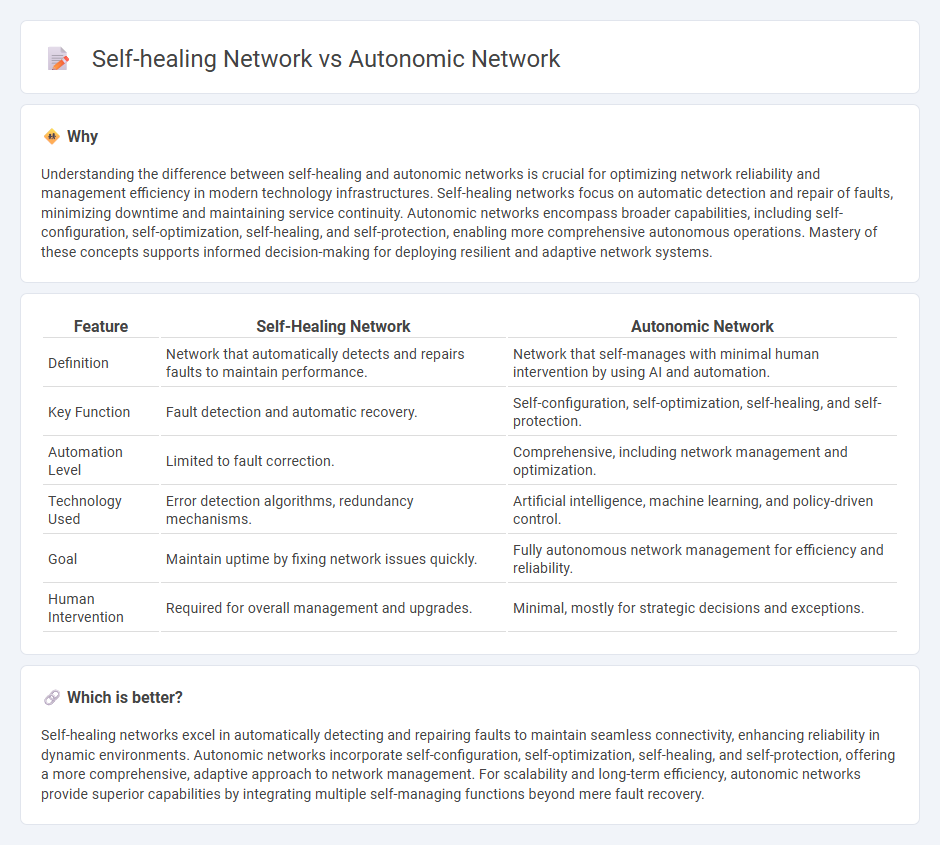
Self-healing networks automatically detect and repair faults to ensure continuous connectivity, reducing downtime and maintenance costs. Autonomic networks extend this capability by incorporating self-configuration, self-optimization, and self-protection for adaptive and intelligent management. Explore the differences and benefits of these advanced network technologies to enhance your IT infrastructure.
Why it is important
Understanding the difference between self-healing and autonomic networks is crucial for optimizing network reliability and management efficiency in modern technology infrastructures. Self-healing networks focus on automatic detection and repair of faults, minimizing downtime and maintaining service continuity. Autonomic networks encompass broader capabilities, including self-configuration, self-optimization, self-healing, and self-protection, enabling more comprehensive autonomous operations. Mastery of these concepts supports informed decision-making for deploying resilient and adaptive network systems.
Comparison Table
| Feature | Self-Healing Network | Autonomic Network |
|---|---|---|
| Definition | Network that automatically detects and repairs faults to maintain performance. | Network that self-manages with minimal human intervention by using AI and automation. |
| Key Function | Fault detection and automatic recovery. | Self-configuration, self-optimization, self-healing, and self-protection. |
| Automation Level | Limited to fault correction. | Comprehensive, including network management and optimization. |
| Technology Used | Error detection algorithms, redundancy mechanisms. | Artificial intelligence, machine learning, and policy-driven control. |
| Goal | Maintain uptime by fixing network issues quickly. | Fully autonomous network management for efficiency and reliability. |
| Human Intervention | Required for overall management and upgrades. | Minimal, mostly for strategic decisions and exceptions. |
Which is better?
Self-healing networks excel in automatically detecting and repairing faults to maintain seamless connectivity, enhancing reliability in dynamic environments. Autonomic networks incorporate self-configuration, self-optimization, self-healing, and self-protection, offering a more comprehensive, adaptive approach to network management. For scalability and long-term efficiency, autonomic networks provide superior capabilities by integrating multiple self-managing functions beyond mere fault recovery.
Connection
Self-healing networks and autonomic networks are interconnected through their shared goal of enhancing network resilience and reducing human intervention by using automated processes. Self-healing networks utilize real-time fault detection and recovery algorithms that are fundamental components of autonomic networking systems designed to self-manage based on policies and environmental changes. These technologies rely heavily on artificial intelligence and machine learning to predict failures, optimize performance, and maintain seamless connectivity across complex digital infrastructures.
Key Terms
Automation
Autonomic networks leverage automated monitoring and self-configuration to proactively manage network performance and security without human intervention. Self-healing networks specialize in rapid fault detection and automated recovery processes to minimize downtime and maintain seamless connectivity. Explore how these advanced automation technologies transform network reliability and efficiency.
Fault Detection
Autonomic networks utilize advanced algorithms and machine learning for proactive fault detection, enabling real-time identification and prediction of potential network issues. Self-healing networks focus specifically on fault detection through continuous monitoring and automated fault isolation, allowing rapid recovery and minimal downtime. Discover more about how these network technologies enhance reliability and performance.
Self-management
Autonomic networks are designed with self-management capabilities that enable automatic configuration, optimization, and healing without human intervention. Self-healing networks specifically target fault detection and recovery processes to maintain service continuity by minimizing downtime. Explore further to understand how these technologies revolutionize network reliability and efficiency.
Source and External Links
Autonomic networking - Wikipedia - Autonomic networking is a concept inspired by autonomic computing, aiming to create self-managing networks with flexible, dynamic architectures using principles like compartmentalization, function re-composition, and closed control loops to enable large-scale autonomic network formation.
Central Control of the Autonomic Nervous System and ... - The central autonomic network (CAN) in the brain controls autonomic functions by regulating sympathetic and parasympathetic outflows through hypothalamic and other brain nuclei, coordinating autonomic responses to stress like heart rate and blood pressure changes.
1 Central Autonomic Network - Oxford Academic - The CAN is composed of brain regions at the forebrain, brainstem, and spinal levels that modulate autonomic nervous system activity to maintain homeostasis and adapt to internal and external challenges by integrating sensory, emotional, and autonomic signals.
 dowidth.com
dowidth.com